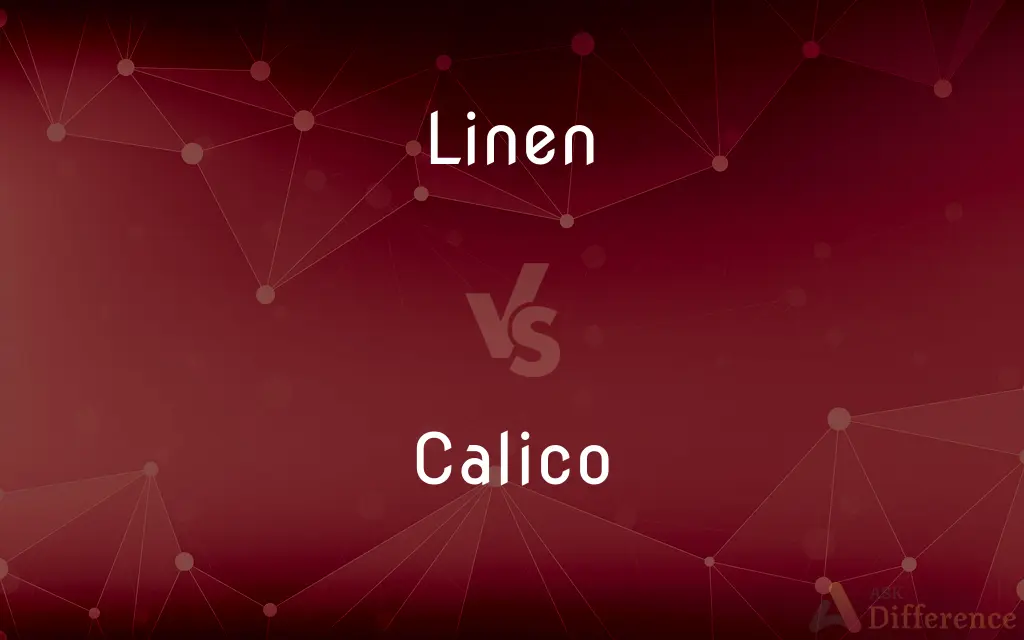Linen vs. Calico — What's the Difference?
Edited by Tayyaba Rehman — By Urooj Arif — Updated on March 27, 2024
Linen is a natural fabric made from flax fibers, known for its strength, breathability, and coolness, ideal for summer wear; calico is a plain-woven cotton fabric, unbleached and not fully processed, versatile for crafts and clothing.

Difference Between Linen and Calico
Table of Contents
ADVERTISEMENT
Key Differences
Linen, derived from the flax plant, is celebrated for its durability, natural luster, and exceptional coolness in hot weather, making it a preferred choice for high-quality summer clothing and bed linens. In contrast, calico is a type of cotton fabric that is typically unbleached and not fully processed, giving it a rustic, natural appearance. It is commonly used for mock-ups in dressmaking, crafts, and occasionally in finished clothing, especially in historical or traditional designs.
The production process of linen involves labor-intensive methods to extract the fibers from the flax plant, contributing to its higher cost compared to cotton-based calico. This process, along with linen's natural properties, gives it a unique texture and feel, which becomes softer and more absorbent with each wash. Calico, while simpler and less expensive to produce, offers a versatile canvas for dyeing, printing, and other textile arts, making it a favorite among crafters and designers for its natural, unfinished look and feel.
Linen is highly valued for its breathability and moisture-wicking properties, which make it particularly suited for warm climates and sensitive skin. It is also biodegradable and environmentally friendly, requiring fewer pesticides and water to grow than cotton. Calico, on the other hand, holds significance in the world of sustainable fashion and DIY projects, as its unprocessed state means it retains more of the cotton's natural qualities, including its softness and durability.
Regarding care and maintenance, linen is known for its tendency to wrinkle, which is often embraced as part of its aesthetic appeal. It requires gentle washing and can be air-dried to preserve its texture and longevity. Calico, being cotton, is easier to care for, with most varieties being machine washable and durable enough for everyday use.
The historical context of both fabrics adds to their appeal: linen, with its ancient origins, has been a symbol of luxury and cleanliness for millennia, while calico, with its roots in the Indian subcontinent, played a significant role in the textile trade and the history of fashion. Both fabrics offer a connection to the past, with linen evoking a sense of timeless elegance and calico a rustic charm.
ADVERTISEMENT
Comparison Chart
Material Source
Flax plant fibers
Cotton
Texture
Smooth, becomes softer over time
Rough, natural texture
Uses
Summer clothing, bed linens, home textiles
Crafts, mock-ups, traditional clothing
Production Cost
Higher, due to labor-intensive processing
Lower, simpler processing
Environmental Impact
Less water, fewer pesticides
Depends on cultivation practices
Durability
Strong, long-lasting
Durable but varies with processing
Care
Gentle wash, prone to wrinkling
Generally easy care, machine washable
Breathability
Highly breathable, moisture-wicking
Good breathability
Historical Significance
Ancient luxury, cleanliness symbol
Textile trade, sustainable fashion
Aesthetic
Natural luster, elegance
Rustic charm, unfinished look
Compare with Definitions
Linen
Made from flax fibers.
The linen shirt felt cool and comfortable in the summer heat.
Calico
Plain-woven cotton fabric.
The calico bag was sturdy yet lightweight for daily use.
Linen
Known for strength and durability.
Linen tablecloths are prized for their longevity.
Calico
Versatile for crafts and clothing.
She used calico for her quilt projects because of its durability.
Linen
Tends to wrinkle easily.
The linen dress's natural wrinkles added to its relaxed elegance.
Calico
Unbleached, rustic appearance.
Calico curtains added a warm, natural feel to the room.
Linen
Luxurious and environmentally friendly.
Choosing linen apparel supports sustainable fashion.
Calico
Economical fabric choice.
Calico is a cost-effective material for dressmaking prototypes.
Linen
Highly breathable fabric.
Linen bedding is ideal for a restful night's sleep in any season.
Calico
Holds historical significance.
Calico played a crucial role in the early textile trade.
Linen
Linen () is a textile made from the fibers of the flax plant. Linen is very strong, absorbent, and dries faster than cotton.
Calico
Calico (; in British usage since 1505) is a plain-woven textile made from unbleached, and often not fully processed, cotton. It may also contain unseparated husk parts.
Linen
Cloth woven from flax
A linen suit
He dealt in Irish linens
Calico
A tightly woven cotton cloth having a repeating, often floral design.
Linen
Thread made from fibers of the flax plant.
Calico
Chiefly British A plain white cotton cloth, heavier than muslin.
Linen
Cloth woven from this thread.
Calico
An animal, such as a cat, having a coat of white fur with distinct patches of different colors, usually reddish-orange and black.
Linen
Also linens Articles or garments, such as sheets, tablecloths, or underwear, formerly made of linen and now usually made of other fabrics, especially cotton.
Calico
(textiles) A kind of rough cloth made from unbleached and not fully processed cotton, often printed with a bright pattern.
Linen
Paper made from flax fibers or having a linenlike luster.
Calico
Ellipsis of calico cat
Linen
Made of flax or linen.
Calico
(uncountable) The plant disease caused by Tobacco mosaic virus.
Linen
Resembling linen.
Calico
Made of calico or resembling the color of calico cloth, having a pattern of red and contrasting areas; variegated.
The calico cat had distinctive red and dark markings.
The calico-patterned tablecloths were supposed to make the restaurant look rustic; instead, they made it look run down.
Linen
(uncountable) Thread or cloth made from flax fiber.
Calico
Plain white cloth made from cotton, but which receives distinctive names according to quality and use, as, super calicoes, shirting calicoes, unbleached calicoes, etc.
The importation of printed or stained colicoes appears to have been coeval with the establishment of the East India Company
Linen
(countable) Domestic textiles, such as tablecloths, bedding, towels, underclothes, etc., that are made of linen or linen-like fabrics of cotton or other fibers; linens.
She put the freshly cleaned linens into the linen closet.
Calico
Cotton cloth printed with a figured pattern.
Linen
A light beige colour, like that of linen cloth undyed.
Calico
Made of, or having the appearance of, calico; - often applied to an animal, as a horse or cat, on whose body are large patches of a color strikingly different from its main color.
Linen
Made from linen cloth or thread.
Calico
Coarse cloth with a bright print
Linen
Having the colour linen, light beige.
Calico
Made of calico or resembling calico in being patterned;
Calico dresses
A calico cat
Linen
Made of linen; as, linen cloth; a linen stocking.
Calico
Having sections or patches colored differently and usually brightly;
A jester dressed in motley
The painted desert
A particolored dress
A piebald horse
Pied daisies
Linen
Resembling linen cloth; white; pale.
Linen
Thread or cloth made of flax or (rarely) of hemp; - used in a general sense to include cambric, shirting, sheeting, towels, tablecloths, etc.; as, bed linens
Linen
Underclothing, esp. the shirt, as being, in former times, chiefly made of linen.
Linen
A fabric woven with fibers from the flax plant
Linen
A high-quality paper made of linen fibers or with a linen finish
Linen
White goods or clothing made with linen cloth
Common Curiosities
Can both linen and calico be dyed?
Yes, both fabrics can be dyed, but linen's natural luster and calico's absorbent qualities offer different aesthetic outcomes.
How does the cost of linen compare to calico?
Linen is generally more expensive than calico due to its labor-intensive production process.
Which fabric is more environmentally friendly?
Linen is often considered more environmentally friendly due to its lower water and pesticide requirements, but calico can also be sustainable depending on the cotton's cultivation practices.
What is linen made from?
Linen is made from the fibers of the flax plant, known for its durability and breathability.
Are linen and calico suitable for summer clothing?
Yes, both are suitable for summer due to their breathability, but linen is particularly valued for its coolness and moisture-wicking properties.
How do you care for linen and calico fabrics?
Linen requires gentle washing and air-drying to prevent excessive wrinkling, while calico is generally easier to care for and can be machine washed.
What is calico used for?
Calico is used for a variety of purposes, including crafts, dressmaking mock-ups, and traditional clothing.
Why choose calico for craft projects?
Calico is chosen for its versatility, natural texture, and cost-effectiveness, making it ideal for a wide range of craft and sewing projects.
Can linen be used for upholstery?
Yes, linen's durability and elegant appearance make it a popular choice for upholstery and home textiles.
What makes linen fabrics unique?
Linen's unique qualities include its natural luster, strength, and ability to improve with age, becoming softer with each wash.
What are the historical uses of calico?
Historically, calico was used in clothing, home décor, and by various cultures for its affordability and versatility.
Is calico the same as muslin?
No, calico and muslin are different; calico is generally heavier and not fully processed, while muslin is finer and more delicately woven.
Which fabric is better for sensitive skin?
Linen is often preferred for sensitive skin due to its natural anti-allergenic and moisture-wicking properties.
Share Your Discovery

Previous Comparison
Perform vs. Carryout
Next Comparison
Saudi vs. DubaiAuthor Spotlight
Written by
Urooj ArifUrooj is a skilled content writer at Ask Difference, known for her exceptional ability to simplify complex topics into engaging and informative content. With a passion for research and a flair for clear, concise writing, she consistently delivers articles that resonate with our diverse audience.
Edited by
Tayyaba RehmanTayyaba Rehman is a distinguished writer, currently serving as a primary contributor to askdifference.com. As a researcher in semantics and etymology, Tayyaba's passion for the complexity of languages and their distinctions has found a perfect home on the platform. Tayyaba delves into the intricacies of language, distinguishing between commonly confused words and phrases, thereby providing clarity for readers worldwide.














































